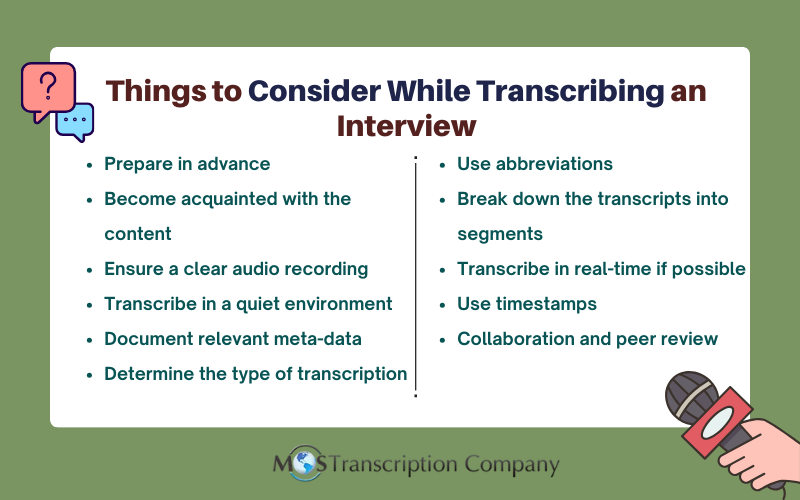As a journalist, researcher, content creator, or other professional, conducting interviews to gather firsthand accounts of experiences or opinions is an essential aspect of your work. When it comes to transcribing these interviews, accuracy and efficiency are crucial for analyzing the content and gaining valuable insights from it. You may be wondering how to tackle this multifaceted process, which depends on various factors like audio recording quality, typing speed, number of speakers, accents, and more.
If you find yourself dealing with a large volume of interviews, using professional interview transcription services is the ideal solution. However, if you prefer the DIY approach, you may face a time-consuming and challenging task. But don’t worry! By following some best practices, you can improve your efficiency and accuracy in the audio transcription process.
Tips to Improve Interview Transcription Efficiency
Here are some essential things to consider while transcribing an interview:
Prepare in advance
Before starting the interview transcription, make sure you have the necessary tools and resources. It’s essential to have a reliable audio recording device or software, a comfortable workspace, a high-quality headset, and a transcription tool or text editor. Make sure you know how to use the tools and that they are in working properly.
Become acquainted with the content
Before you begin the transcription process, spend some time familiarizing yourself with the interview’s context. Gaining a grasp of the context, subject matter and accents can significantly enhance the precision of your transcription efforts.
Ensure a clear audio recording
To ensure accurate transcription, it is crucial to have a clear and high-quality audio recording of the interview. Position the recording device close to the interviewee, eliminating any background noise or interference. If the audio quality is poor, consider using audio enhancement software to improve clarity before starting the transcription.
Transcribe in a quiet environment
Distractions and background noise can hinder the transcription process. Choose a quiet and comfortable workspace where you can focus solely on listening and typing.
Document relevant meta-data
When preparing to transcribe an interview in a Word document, it is essential to document relevant meta-data at the document’s top. This includes information such as the Interview ID#, Project name, Participant’s name or initials (ensuring confidentiality is maintained), Interview group (if applicable, like client, program manager, or funder), Interviewer’s name, Date of the interview, Location of the interview, and the Transcriptionist’s name. These details provide essential information about the interview and help maintain organization and clarity during the transcription process. Capturing these details at the outset also ensures that the transcription is contextually rich and easily retrievable when needed.
Determine the type of transcription
Determine the transcription format for documenting your interviews. Based on your needs, you can choose from different types of transcription formats: verbatim, edited, and intelligent verbatim.
In verbatim transcription, both the verbal and non-verbal components of the audio content are captured. This includes fillers, stammers, and expressions, providing a detailed account of the interview. Noting non-verbal cues such as pauses, laughter, hesitations and other non-verbal cues can ensure the transcript accurately represents the conversation.
Edited transcription involves correcting grammatical issues and excluding unnecessary content such as incomplete sentences and slang. The goal is to improve readability and clarity while maintaining the essence of the interview.
Intelligent verbatim transcription involves light editing to correct grammatical errors, remove repetitions, hesitations, and verbal utterances like uhs and ums. Pauses are also eliminated, and long, rambling sentences are restructured to enhance coherence and readability.
Use abbreviations
When transcribing, make use of shorthand and abbreviations to increase your typing speed. Develop a set of standardized abbreviations for commonly used words or phrases in the interview context. Make sure to use consistent and easily understandable abbreviations to maintain clarity and accuracy.
Break down the transcripts into segments
Rather than trying to transcribe the entire interview in one go, break it down into manageable segments. Divide the interview into logical sections or time intervals, and transcribe them one at a time. This approach helps maintain focus and prevents mental fatigue, resulting in better accuracy.
Transcribe in real-time if possible
Transcribing the interview in real-time can significantly improve efficiency. Real-time transcription allows you to capture the nuances, tone, and non-verbal cues more accurately, resulting in a more comprehensive transcript. Specialized transcription software allows you to type while the interview is ongoing. There are various options available, ranging from basic software to advanced tools that offer features like automated speech recognition (ASR) and natural language processing (NLP). Explore the software’s features, shortcuts, and customization options and practice using it to increase interview transcription efficiency.
Use timestamps
Time stamps help in easily locating specific portions of the interview. With these markers you can cross-reference the transcript with the original audio and ensure the transcribed content reflects what was actually said during the interview. Place timestamps at important moments or when the conversation shifts to a new topic.
Collaboration and peer review
If you are part of a transcription team, get feedback from the others. Peer review can help identify errors, inconsistencies, and areas for improvement. For example, If you come across a particularly tricky passage or terminology, don’t hesitate to seek input from your fellow transcriptionists. By working together, you can enhance the accuracy and efficiency of the overall transcription process.
To achieve efficiency and accuracy in interview transcription, it is crucial to adopt a methodical and well-organized approach. By employing the above-listed strategies, you can improve your transcription skills and generate top-notch transcripts. It is important to note that while transcription software can expedite the process, it may introduce inconsistencies or misinterpretations. Therefore, after transcribing the interview, make sure to thoroughly review the transcript to identify and correct any errors, typos, or inaccuracies. If you have a large volume of interviews to transcribe, reaching out to an online transcription company can be a practical solution to streamline the process, save time, and ensure precise results.
Explore our services for seamless efficiency and accuracy.





